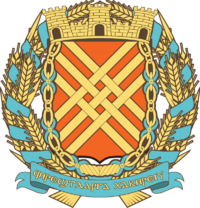Girbetese Bakir
| ϣⲓⲣⲃⲉⲧⲁⲕ ⲃⲁⲕⲓⲣ Romanized: Jiyrbetäk Bakir | |
|---|---|
| ISO 4217 | |
| Unit | |
| Plural | Bakirs |
| Symbol | ฿ |
| Denominations | |
| Subunit | |
| 1/100 | Täñ |
| Plural | |
| Täñ | Täñs |
| Banknotes | ฿1, ฿5, ฿10, ฿20, ฿50, ฿100 ฿500, ฿1000 (Rarely Used) |
| Coins | 5, 10, 20, 50 täñ 100 tañ/฿1(Rarely Used) |
| Demographics | |
| User(s) | |
| Issuance | |
| Central bank | Girbetan National Reserve Bank (ⲙⲓⲗⲓ ⲣⲉⲍⲉⲣvⲃⲁⲛⲕⲩ ϣⲓⲣⲃⲉⲧⲁⲕ Romanized: Milli Rezervbanky Jiyrbetäk) |
| Valuation | |
| Inflation | 2.1% |
| Source | November 2019 |
The Girbetese Bakir (plural: bakirs, symbol: ฿, currency code: GIB) is the currency of Girbeta. It is divided into 100 Täñs (cents). The Bakir is issued by the Girbetan National Reserve Bank.
A precursor of the Bakir was the currency of the Tichva Confederacy, as copper ore was notably plentiful on the islands which make up modern-day Jardan, and was minted into coinage. It was notably the first currency outside of Asura to decimalize, with the introduction of the standardized 100 Täñ subunit being introduced c. 1580. Following the Confederacy's defeat in the Miricio-Girbetese War and subsequent colonization by the Mirician Empire in 1602, the term Bakir fell out of use, and was replaced by the Mirician Arre, the currency utilized as part of the Empire's South Seas holdings, also primarily sourced from Jarrese copper mines. The Arre was utilized until 1961.
